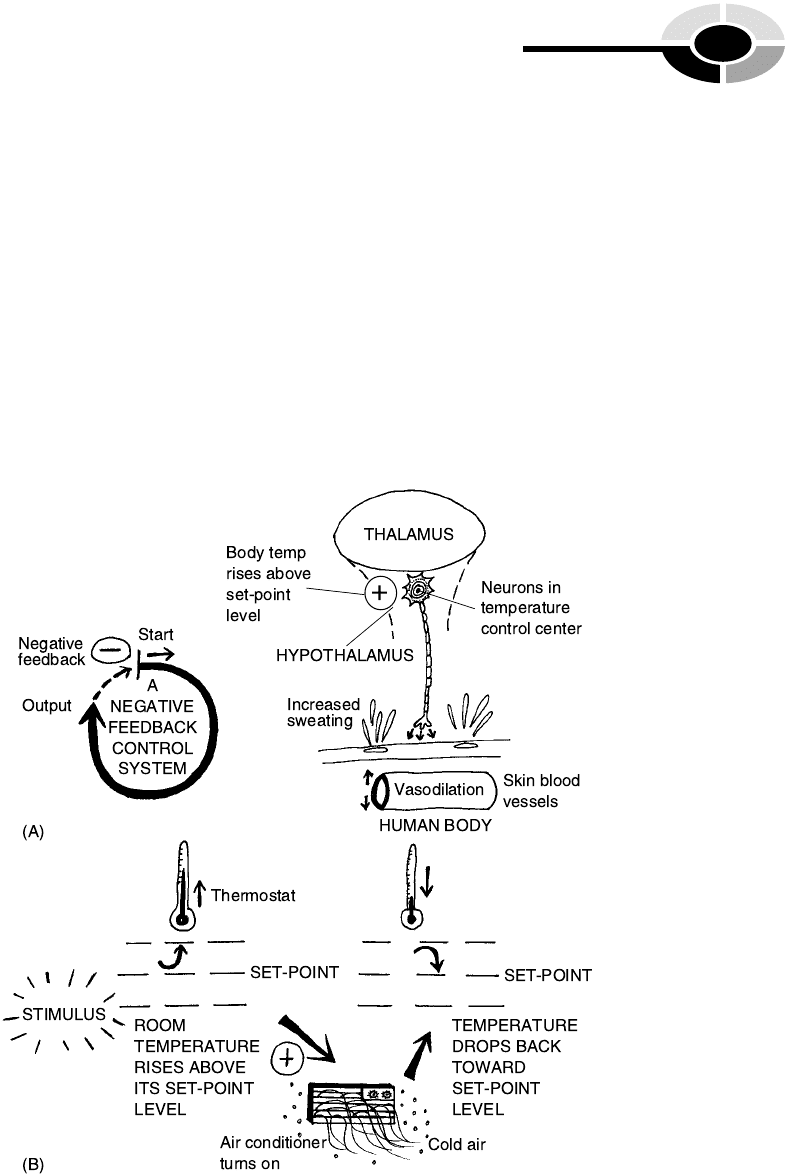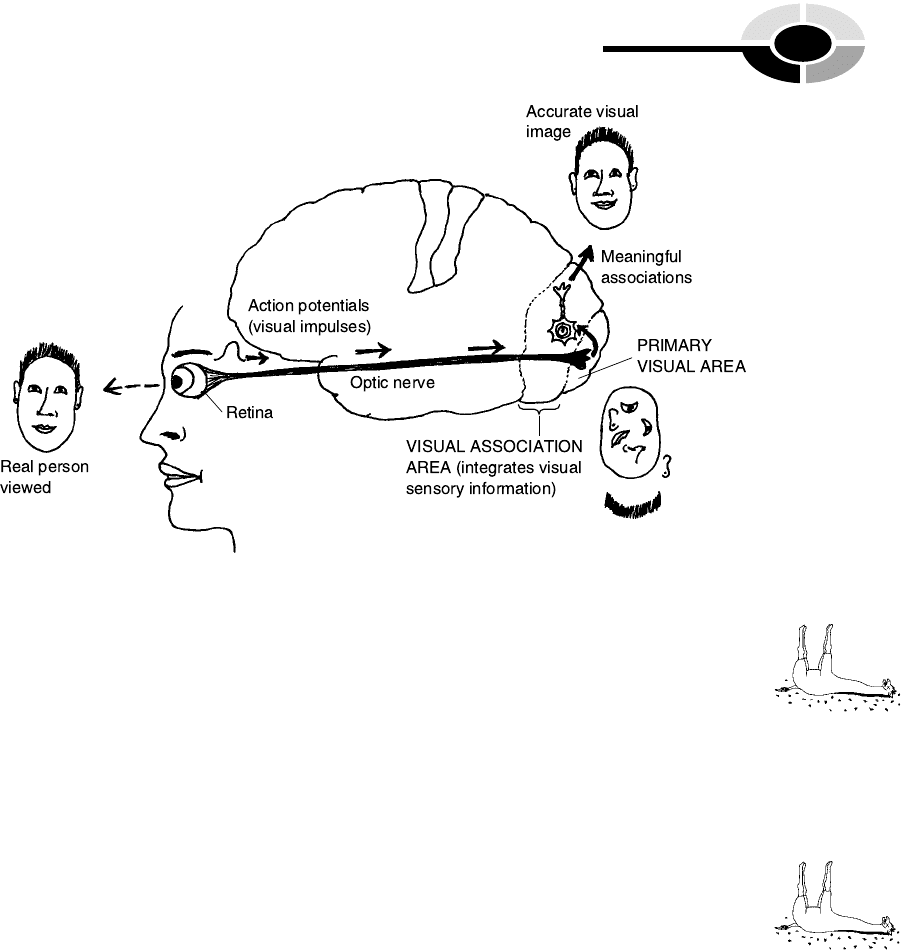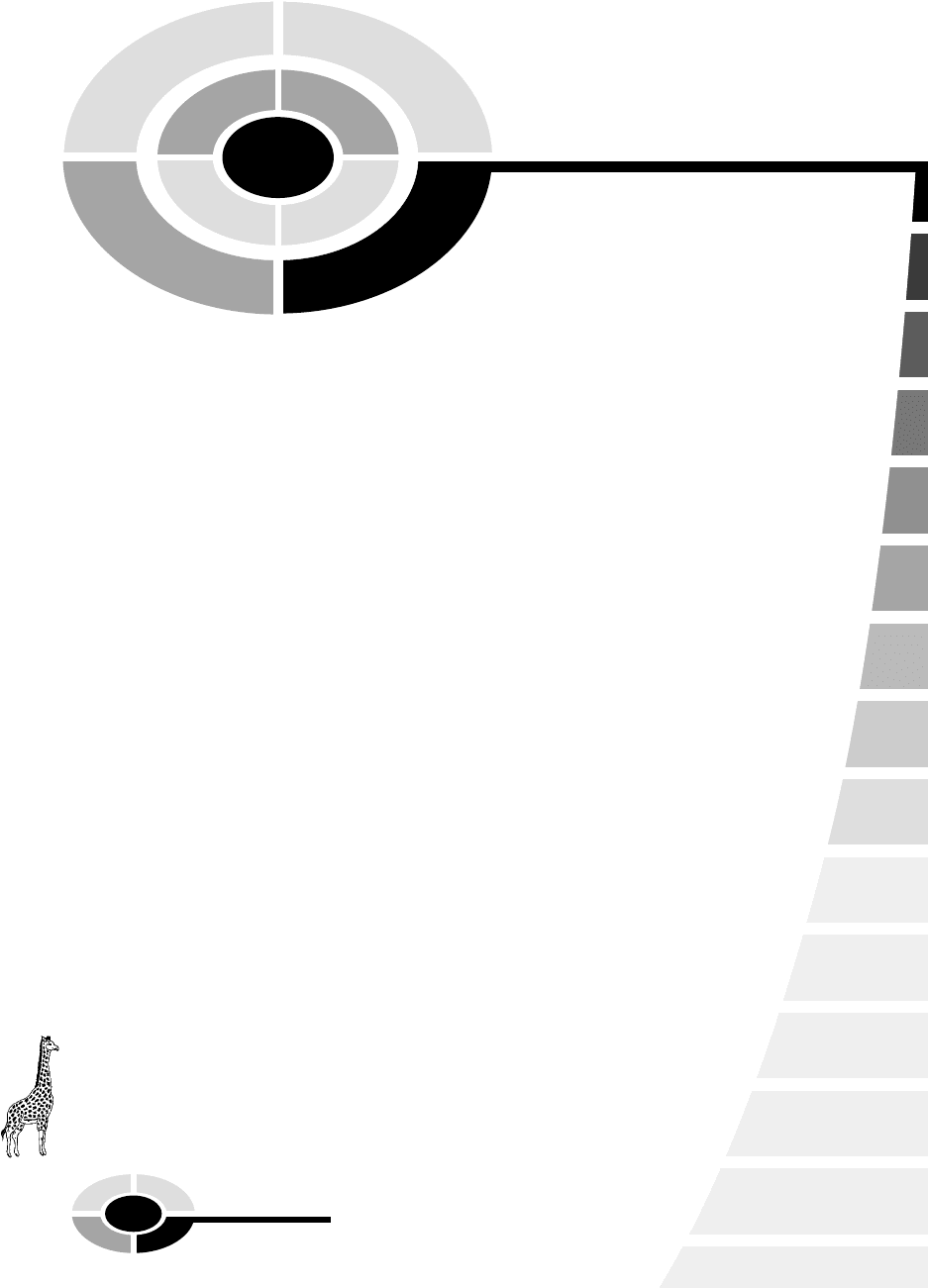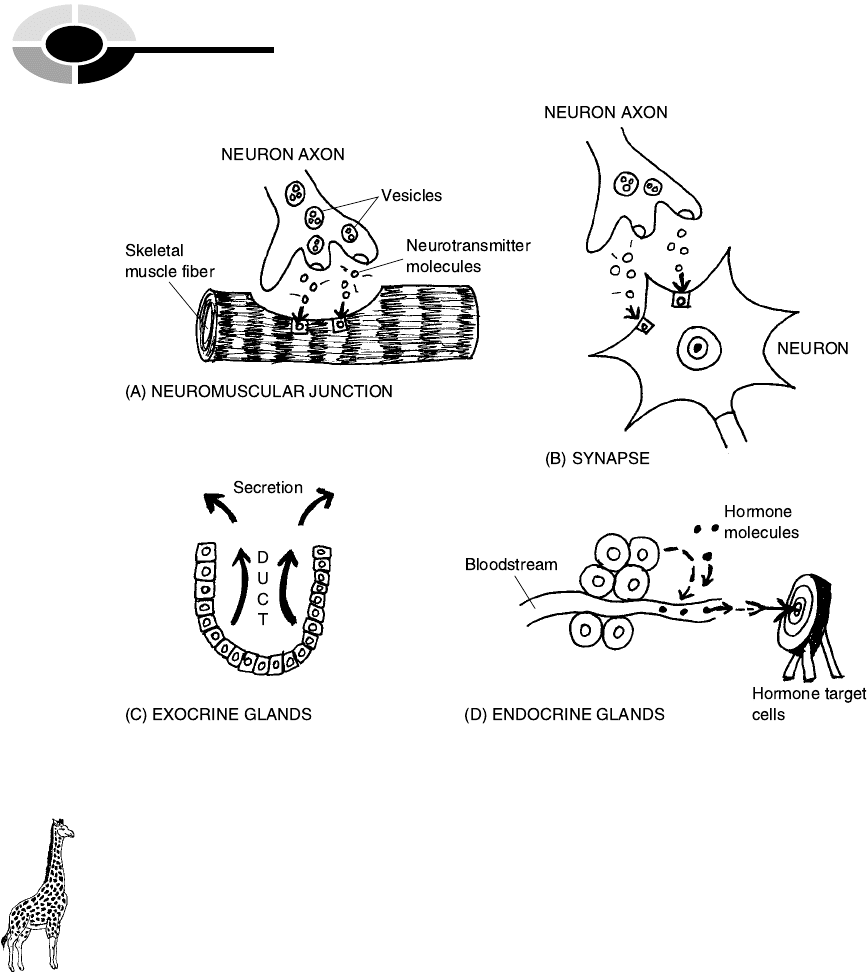Layman D. Biology Demystified: A Self-Teaching Guide
Подождите немного. Документ загружается.


In general, a negative feedback control system is a collection of anatomical
and physiological components that operate to produce an outcome or response
which curves or feeds back upon the initial stimulus in a negative manner. By
this it is meant that the final outcome of the system curves (feeds back) upon the
initial stimulus to remove or correct it. (Consult Figure 14.12, A.)
Consider, for instance, a situation where the temperature in a room starts
to rise above its set-point value on the thermostat (Figure 14.12, B). As the
temperature begins to rise towards the upper limit of its normal range, a
negative feedback temperature control system kicks in. The rise in tempera-
ture acts as a stimulus for the air conditioner in the unit. It begins to blow
cold air into the room. Soon, the room temperature drops back down
towards its set-point value on the thermostat. The intial stimulus (rise in
CHAPTER 14 Neuromuscular Connection 257
[13:26 13/6/03 N:/4058 LAYMAN.751/4058-Alltext.3d] Ref: 4058 Layman: Biology Demystified All-text Page: 257 1-388
Fig. 14.12 Negative feedback control of temperature.

room temperature above the set-point level) has therefore been corrected or
removed. Hence, a negative feedback control system has been in operation.
Within the human body, of course, increased sweating and vasodilation of
skin blood vessels would have a similar negative feedback effect upon any
significant rise in oral body temperature beyond its set-point of about 98.6
degrees F. A group of neurons within the temperature control center of the
hypothalamus direct this sweating and vasodilation process to occur.
In addition to the temperature control center, the hypothalamus has
numerous other control centers. These include a hunger center, thirst center,
pleasure center, and many other centers that help control some important
body variable and thus maintain homeostasis.
Integration and Association Areas of the Brain
In addition to the major motor and sensory areas of the Central Nervous
System (brain and spinal cord), there are a number of critical sensory inte-
gration or association areas. These areas make meaningful connections or
associations between incoming stimuli, so that recognition and learning
tend to occur. Take, for instance, the primary visual area at the back of the
cerebrum, and the visual association area located just in front of it (Figure
14.13). The primary visual area receives visual impulses from the retina
(RET-ih-nah) in the rear wall of the eyeball. These visual impulses travel
to the primary visual area over the optic (AHP-tik) nerves. But these visual
impulses don’t make any sense to us until they are sent forward to the visual
association area. Here the separate bits of visual information are ordered and
assembled into meaningful patterns and images that we can recognize, such
as the familiar face of a good friend.
Neuromuscular Disorders: Breaking the
Connections
We have now outlined some of the major aspects of the nervous and mus-
cular systems. Primarily, this outline has involved basic features of their
normal anatomy and physiology. To a large degree, these two systems are
functionally linked due to the extremely high degree of Biological Order
found in the connections between them. Hence, neuromuscular disorders,
[13:26 13/6/03 N:/4058 LAYMAN.751/4058-Alltext.3d] Ref: 4058 Layman: Biology Demystified All-text Page: 258 1-388
PART 4 Anatomy and Physiology of Animals
258

and the disease/injury states often associated with them, frequently result
from the breaking or disruption of the normal connections between muscles
and nerves.
PARALYSIS AND DENERVATION ATROPHY
Consider what happens, for instance, when part of the major motor pathway
descending to the skeletal muscles is transected (tran-SEK-ted) or ‘‘cut’’ (sect)
all the way ‘‘through’’ (trans-). When the motor nerve fibers from the pre-
central gyrus (primary motor area) are transected (cut all the way through),
say, from a terrible car accident, then either partial or full paralysis (puh-
RAL-uh-sis) of the body occurs. Paralysis is literally a state of ‘‘disablement,’’
an inability to move. The axons of the motor neurons leading from the motor
areas of the cerebral cortex are unable to complete their final connection with
the neuromuscular junction (motor end plate).
As a result, there is either a full or total paralysis of the skeletal muscles
being supplied. [Study suggestion: If the main motor pathway leading down
from the left precentral gyrus is transected, then many of the skeletal muscles
on which side of the body will be paralyzed? Why?]
Troph (TROHF) is a root that means ‘‘nourishment.’’ But troph means
nourishment in its broadest sense, including ‘‘stimulation.’’ The skeletal
CHAPTER 14 Neuromuscular Connection 259
[13:26 13/6/03 N:/4058 LAYMAN.751/4058-Alltext.3d] Ref: 4058 Layman: Biology Demystified All-text Page: 259 1-388
Fig. 14.13 The primary visual and visual association areas.
1, Disorder
2, Disorder

[13:26 13/6/03 N:/4058 LAYMAN.751/4058-Alltext.3d] Ref: 4058 Layman: Biology Demystified All-text Page: 260 1-388
PART 4 Anatomy and Physiology of Animals
260
3, Disorder
muscle fibers, then, receive ‘‘nourishment’’ by the motor nerve fibers coming
down to the neuromuscular junction, because they are stimulated to contract
by them. In technical terms, we say that the skeletal muscle fibers are inner-
vated (IN-ur-vayt-ed) or have ‘‘nerve’’ (nerv) endings put ‘‘into’’ (in-) them.
This situation of innervation (in-er-VAY-shun) essentially occurs at the
neuromuscular junction. The skeletal muscle fibers are therefore innervated
at the neuromuscular junction and receive nourishment or stimulation
(troph) from them.
Denervation (dee-ner-VAY-shun) is the ‘‘process of ’’ (-tion) taking
‘‘nerves’’ (nerv) ‘‘away from’’ (de-) muscle fibers. If some part of the motor
nerve pathway undergoes transection, then the skeletal muscle fibers ulti-
mately being served by the pathway will suffer denervation. They will also
undergo a type of atrophy (AT-ruh-fee) – a ‘‘condition’’ (-y) ‘‘without’’ (a-)
‘‘nourishment’’ (troph) or stimulation.
The complete phrase is denervation atrophy, which means the wasting
away and degeneration of skeletal muscle fibers that have been deprived of
their normal stimulation or nourishment by nerve endings. The denervated
(DEH-ner-vayt-ed) muscles become flaccid (FLAH-sid) or ‘‘flabby’’ and
almost useless.
ANESTHESIA – LOSS OF FEELING OR SENSATION
When the sensory nerve fibers leading from sensory receptors in muscles,
joints, skin, or elsewhere are transected, then anesthesia (an-es-THEE-
zhuh) often results. Anesthesia is a ‘‘condition’’ (-ia) ‘‘without’’ (an-) ‘‘feeling
or sensation’’ (esthes).
If, for instance, the sensory nerves leading from most of the receptors in
your big toe are completely transected, then the big toe is pretty much numb,
reflecting a condition of anesthesia. [Study suggestion: Assume that the main
sensory nerve pathway ascending from your right big toe is completely trans-
ected. Going back and reviewing past figures in this chapter, which specific
gyrus area receiving big toe sensations would be deprived? On which side of
the body midline would it most likely be located?]
Quiz
Refer to the text in this chapter if necessary. A good score is at least 8 correct
answers out of these 10 questions. The answers are listed in the back of this
book.

1. The muscular system of humans:
(a) Involves mainly the muscles in the walls of the heart
(b) Is chiefly composed of over 600 individual skeletal muscle organs
(c) Focuses upon about 700 pairs of skeletal muscle tissues
(d) Bears no relationship to bones or tendons
2. The masseter muscle in the jaw is named for the characteristic of:
(a) Muscle shape
(b) Body location
(c) Major body action
(d) Number of muscle heads
3. In bending and straightening of the lower leg, the knee joint serves as a:
(a) Fulcrum
(b) Lever
(c) Resistance
(d) Pulling force
4. When the biceps brachii contracts, it flexes (bends) the lower arm at the
elbow. The insertion of the biceps brachii must therefore be at the:
(a) Shoulder
(b) Wrist
(c) Fingers
(d) Elbow
5. Epimysium represents:
(a) A special type of joint
(b) A type of fascia located upon an entire skeletal muscle
(c) Fascia located around a bundle of muscle fibers
(d) Striated muscle fibers
6. The striations of an individual skeletal muscle fiber are chiefly due to:
(a) A stack of light I bands within the myofibrils
(b) Several groups of muscle cell nuclei closely adjacent to one another
(c) A stack of dark A bands within the myofibrils
(d) Complete lack of any significant organelle banding patterns
7. The thin myofilaments primarily consist of the protein _____
(a) Actin
(b) Myosin
(c) Z-line
(d) Cross-bridge substance
CHAPTER 14 Neuromuscular Connection 261
[13:26 13/6/03 N:/4058 LAYMAN.751/4058-Alltext.3d] Ref: 4058 Layman: Biology Demystified All-text Page: 261 1-388

8. According to modern theory, a muscle fiber contracts because:
(a) Its thin myofilaments become shorter
(b) The relaxation of the muscle is no longer being opposed
(c) The thick myofilaments lengthen considerably
(d) The thin myofilaments slide inward over the tilted cross-bridges of
myosin
9. The neuromuscular junction is alternately called the:
(a) Hypothalamus
(b) Motor end plate
(c) Axon terminals
(d) Vesicles
10. Many sensory nerve fibers ascend and relay to the cerebral cortex, and
its:
(a) Postcentral gyrus
(b) Thalamus
(c) Hypothalamus
(d) Primary motor area
The Giraffe ORDER TABLE for Chapter 14
(Key Text Facts About Biological Order Within An Organism)
1. ____________________________________________________________
2. ____________________________________________________________
3. ____________________________________________________________
4. ____________________________________________________________
5. ____________________________________________________________
[13:26 13/6/03 N:/4058 LAYMAN.751/4058-Alltext.3d] Ref: 4058 Layman: Biology Demystified All-text Page: 262 1-388
PART 4 Anatomy and Physiology of Animals
262

The Dead Giraffe DISORDER TABLE for Chapter 14
(Key Text Facts About Biological Disorder Within An Organism)
1. ____________________________________________________________
2. ____________________________________________________________
3. ____________________________________________________________
CHAPTER 14 Neuromuscular Connection 263
[13:26 13/6/03 N:/4058 LAYMAN.751/4058-Alltext.3d] Ref: 4058 Layman: Biology Demystified All-text Page: 263 1-388

[13:26 13/6/03 N:/4058 LAYMAN.751/4058-Alltext.3d] Ref: 4058 Layman: Biology Demystified All-text Page: 264 1-388
264
CHAPTER
15
Glands and Their
Hormone Messengers
Chapter 14 outlined the neuromuscular system. It included a description of
the nerve impulse or action potential, a traveling wave of chemical excitation.
Remember that this traveling wave allows a motor neuron to stimulate ske-
letal muscle fibers at the neuromuscular junction, and it permits one neuron
to communicate with other neurons across a synapse (SIN-aps). A synapse is
literally the place where two neurons come very close (without touching), so
that they almost ‘‘fasten together.’’
Two Solutions to Communication:
Neurotransmitters versus Secretions
The synapse between two neurons, like the neuromuscular junction between
a motor neuron and a muscle fiber, employs a special type of chemical com-
munication (see Figure 15.1, A and B). Specifically, vesicles within the axon
1, Order
Copyright 2003 by The McGraw-Hill Companies, Inc. Click Here for Terms of Use.

terminals of an excited neuron rupture and release neurotransmitter mole-
cules (such as acetylcholine). The neurotransmitter molecules then diffuse
and bind to the membrane of either another neuron (in the case of a synapse)
or a skeletal muscle fiber (in the case of a neuromuscular junction). In both
cases, however, there is a type of chemical communication between cells that
occurs with the release of neurotransmitter molecules.
GLANDS AND SECRETION
But there is another mode or way of chemical communication between cells.
This mode is called secretion (sih-KREE-shun). Secretion is literally the ‘‘pro-
cess of separating’’ – the separation of certain substances from the blood-
stream, followed by their release.
The secreted (see-KREE-ted) substance usually comes from epithelial cells.
Remember (Chapter 2) that epithelial tissue is the body’s main covering and
lining tissue. But it also occurs within glands. A gland is a ‘‘little acorn’’ – a
rounded, somewhat ‘‘acorn’’-shaped mass of one or more epithelial cells that
have become specialized for the function of secretion.
Exocrine (EK-suh-krin) glands are glands of ‘‘external’’ (exo-) secretion
that release some useful product into a duct, which then carries the secretion
to some body surface (study Figure 15.1, C). A good example of exocrine
glands are the sweat glands of the skin, which secrete sweat into numerous
sweat ducts. Sweat, as you no doubt remember, is a useful product because it
helps cool the body and prevent hyperthermia (excessive body temperature).
Endocrine (EN-doh-krin) glands, in contrast, are glands of ‘‘internal’’
(endo-) secretion that release a hormone into the bloodstream, right within
the gland itself. A hormone is literally ‘‘an arouser’’ (hormon). A hormone is a
chemical messenger secreted into the bloodstream by an endocrine gland. It
gets its name from the fact that the hormone often ‘‘arouses’’ (stimulates)
certain target cells in the body to increase their activity. The target cells of the
hormone may be located far downstream, but the blood will eventually
circulate to bring the hormone molecules to them (see Figure 15.1, D).
The Neuroendocrine System
The endocrine glands, like the nervous system, are vitally important in both
communication and control of the internal environment within the bodies of
CHAPTER 15 Glands and Messengers 265
[13:26 13/6/03 N:/4058 LAYMAN.751/4058-Alltext.3d] Ref: 4058 Layman: Biology Demystified All-text Page: 265 1-388
2, Order
3, Order

vertebrates. In fact, it is sometimes very hard to separate the nervous and
endocrine systems at all! In these cases, we use the term neuroendocrine
(NUR-oh-en-doh-krin) system to describe them. The neuroendocrine system
is an organ system that contains parts of the nervous system, as well as parts
of the endocrine gland system. Thus, communication can occur via release of
neurotransmitters (the nervous component), and also via secretion of parti-
cular hormones into the bloodstream (the endocrine component). We will
now describe some specific examples.
THE HYPOTHALAMUS–PITUITARY CONNECTION
Chapter 14 described the hypothalamus as an area deep within the cerebrum
that contains a number of control centers (such as the temperature control
center) that are vitally important for maintaining various aspects of home-
[13:26 13/6/03 N:/4058 LAYMAN.751/4058-Alltext.3d] Ref: 4058 Layman: Biology Demystified All-text Page: 266 1-388
PART 4 Anatomy and Physiology of Animals
266
Fig. 15.1 Two ways for cells to communicate: Neurotransmitters versus secretions.
4, Order
